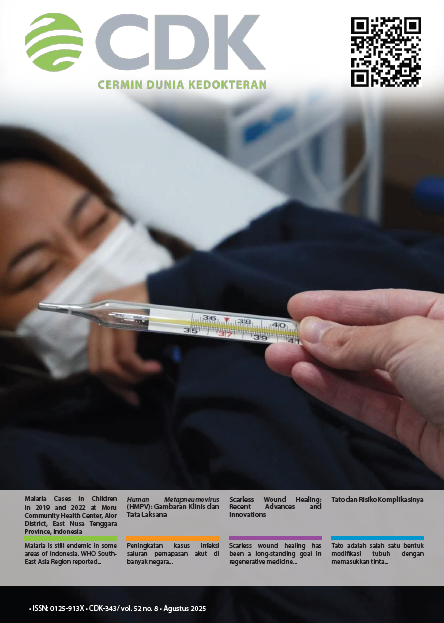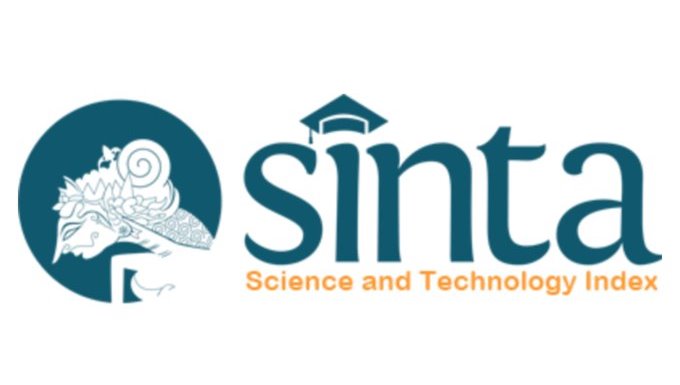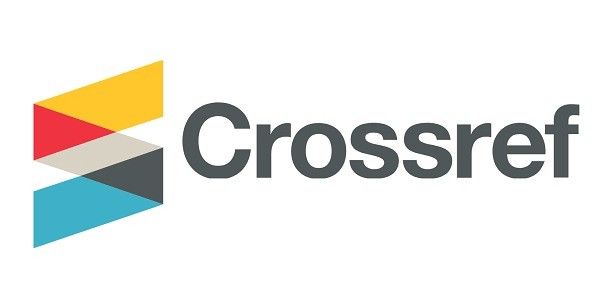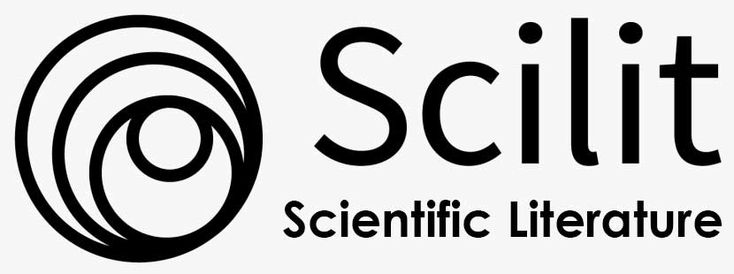Scarless Wound Healing: Recent Advances and Innovations
DOI:
https://doi.org/10.55175/cdk.v52i8.1678Keywords:
Regenerative medicine, scarless healing, wound healingAbstract
Scarless wound healing, a hallmark of mid-gestation fetal skin, is characterized by minimal inflammation, balanced transforming growth factor-β isoforms, and a provisional extracellular matrix rich in type III collagen and hyaluronan. Decades of mechanistic studies have mapped how these features collectively enable rapid, regenerative closure without fibrosis. Contemporary adult-tissue strategies therefore focus on recapitulating the fetal milieu through targeted cytokine modulation, notably down-regulating TGF-β1/β2 while supplementing antifibrotic TGF-β3. Mesenchymal stem cells (MSCs) and their secretome have emerged as potent immunomodulators and angiogenic stimulants that steer wounds toward regeneration rather than scarring. Genetic engineering, biomaterial scaffolds, and extracellular-vesicle delivery platforms further enhance MSC persistence, homing, and paracrine potency. Parallel advances in bio-inspired hydrogels, microneedle arrays, and nanofiber dressings provide spatiotemporal release of growth factors, antimicrobial agents, and oxygen to orchestrate orderly repair. Such combinatorial nanotechnologies not only accelerate re-epithelialization but also limit hypertrophic collagen deposition, leading to flatter, more elastic neodermis.
Downloads
References
Prakoeswa FRS, Satria YAA, Dewi LM. Bedah Buku Sebagai Upaya Peningkatan Pengetahuan Tata Laksana Terkini Ulkus Plantar Kronis Pada Penderita Kusta: Book Review as an Effort to Improve The Knowledge of The Latest Management on Chronic Plantar Ulcus in Leprosy. J Pengabdi Masy Med. 2023;3(1 SE-Articles):1–5. doi: 10.23917/jpmmedika.v3i1.474.
Burrington JD. Wound healing in the fetal lamb. J Pediatr Surg. 1971;6(5):523–8. doi: 10.1016/0022-3468(71)90373-3.
Rowlatt U. Intrauterine wound healing in a 20 week human fetus. Virchows Arch A Pathol Anat Histol. 1979;381(3):353–61. doi: 10.1007/BF00432477.
Gurtner GC, Werner S, Barrandon Y, Longaker MT. Wound repair and regeneration. Nature 2008;453(7193):314–21. doi: 10.1038/nature07039.
Buchanan EP, Longaker MT, Lorenz HP. Fetal skin wound healing. Adv Clin Chem. 2009;48:137–61. doi: 10.1016/s0065-2423(09)48006-5.
Larson BJ, Longaker MT, Lorenz HP. Scarless fetal wound healing: a basic science review. Plast Reconstr Surg. 2010;126(4):1172–80. doi: 10.1097/PRS.0b013e3181eae781.
Ferguson MWJ, O’Kane S. Scar-free healing: from embryonic mechanisms to adult therapeutic intervention. Philos Trans R Soc Lond B Biol Sci. 2004;359(1445):839–50. doi: 10.1098/rstb.2004.1475.
Wu Y, Chen L, Scott PG, Tredget EE. Mesenchymal stem cells enhance wound healing through differentiation and angiogenesis. Stem Cells. 2007;25(10):2648–59. doi: 10.1634/stemcells.2007-0226.
Barrientos S, Brem H, Stojadinovic O, Tomic-Canic M. Clinical application of growth factors and cytokines in wound healing. Wound Repair Regen. 2014;22(5):569–78. doi: 10.1111/wrr.12205.
Foppiani EM, Candini O, Mastrolia I, Murgia A, Grisendi G, Samarelli AV, et al. Impact of HOXB7 overexpression on human adipose-derived mesenchymal progenitors. Stem Cell Res Ther. 2019;10(1):101. doi: 10.1186/s13287-019-1200-6.
Yu Y, Xiao H, Tang G, Wang H, Shen J, Sun Y, et al. Biomimetic hydrogel derived from decellularized dermal matrix facilitates skin wounds healing. Mater Today Bio. 2023;21:100725. doi: 10.1016/j.mtbio.2023.100725.
Li X, Xie X, Lian W, Shi R, Han S, Zhang H, et al. Exosomes from adipose-derived stem cells overexpressing Nrf2 accelerate cutaneous wound healing by promoting vascularization in a diabetic foot ulcer rat model. Exp Mol Med. 2018;50(4):1–14. doi: 10.1038/s12276-018-0058-5.
Kamolz LP, Keck M, Kasper C. Wharton’s jelly mesenchymal stem cells promote wound healing and tissue regeneration. Stem Cell Res Ther. Mei 2014;5(3):62. PMID: 25157597.
Luthfia R, Pramuningtyas R, Dasuki MS, Prakoeswa FRS. Status Gizi dan Personal Hygiene Berpengaruh Terhadap Kusta Wanita di Kabupaten Gresik. In Proceeding Book National Symposium and Workshop Continuing Medical Education XIV; 2021.
Sen CK, Gordillo GM, Roy S, Kirsner R, Lambert L, Hunt TK, et al. Human skin wounds: a major and snowballing threat to public health and the economy. Vol. 17, Wound repair and regeneration : official publication of the Wound Healing Society [and] the European Tissue Repair Society. United States; 2009. pp. 763–71.
Dimawan RSA, Prakoeswa FRS, Pramuningtyas R. Pediatric viral and bacterial skin infection profile. Berk Ilmu Kesehat Kulit dan Kelamin. 2022;34(3):184–8. doi: https://doi.org/10.20473/bikk.V34.3.2022.184-188.
Munawaroh R, Prakoeswa FRS, Kurniawati PM, Hazimah JN, Husna A, Kharisma AN, et al. Peran farmasis sebagai konselor terapi HIV. J Pengabdi Masy Med. 2022;2(1 SE-Articles):29–33. doi: https://doi.org/10.23917/jpmmedika.v2i1.461.
Wihardiyanto O, Prakoeswa FRS, Prakoeswa CRS. The effect of media exposure, family closeness, and knowledge about sexually transmitted disease on sexually transmitted disease risk behaviors in senior high school students. Berk Ilmu Kesehat Kulit dan Kelamin. 2019;31(1):55–9. doi: https://doi.org/10.20473/bikk.V31.1.2019.55-59.
Ratnaasri UD, Pramuningtyas R, Dasuki MS, Prakoeswa FRS. Personal hygiene dan status gizi sebagai faktor risiko kusta anak. In: Personal hygiene and nutritional status as risk factors for leprosy of children. Surakarta: Proceeding Book National Symposium and Workshop Continuing Medical Education XIV; 2021. pp. 554–64.
Cao X, Wu X, Zhang Y, Qian X, Sun W, Zhao Y. Emerging biomedical technologies for scarless wound healing. Bioact Mater. 2024;42:449–77. doi: 10.1016/j.bioactmat.2024.09.001.
Cui K, Gong S, Bai J, Xue L, Li X, Wang X. Exploring the impact of TGF-β family gene mutations and expression on skin wound healing and tissue repair. Int Wound J. 2024;21(4):e14596. doi: 10.1111/iwj.14596.
Al-Attar H, Damiati LA, Keshel SH, Tuinea-Bobe C, Damiati S, Saeinasab M, et al. Effect of TGF-β3 on wound healing of bone cell monolayer in static and hydrodynamic shear stress conditions. Front Med. 2024;11:1328466. doi: 10.3389/fmed.2024.1328466.
Moore AL, Marshall CD, Barnes LA, Murphy MP, Ransom RC, Longaker MT. Scarless wound healing: Transitioning from fetal research to regenerative healing. Wiley Interdiscip Rev Dev Biol. 2018;7(2): 10.1002/wdev.309. doi: 10.1002/wdev.309.
Deng Z, Fan T, Xiao C, Tian H, Zheng Y, Li C, et al. TGF-β signaling in health, disease, and therapeutics. Signal Transduct Target Ther. 2024;9(1):61. doi: 10.1038/s41392-024-01764-w.
Giarratana AO, Prendergast CM, Salvatore MM, Capaccione KM. TGF-β signaling: critical nexus of fibrogenesis and cancer. J Transl Med. 2024;22(1):594. doi: 10.1186/s12967-024-05411-4.
Nurkesh A, Jaguparov A, Jimi S, Saparov A. Recent advances in the controlled release of growth factors and cytokines for improving cutaneous wound healing. Front cell Dev Biol. 2020;8:638. PMID: 32760728.
Yang Y, Suo D, Xu T, Zhao S, Xu X, Bei HP, et al. Sprayable biomimetic double mask with rapid autophasing and hierarchical programming for scarless wound healing. Sci Adv. 2024;10(33):eado9479. doi: 10.1126/sciadv.ado9479.
Huang J, Jiang T, Li J, Qie J, Cheng X, Wang Y, et al. Biomimetic corneal stroma for scarless corneal wound healing via structural restoration and microenvironment modulation. Adv Healthc Mater. 2024;13(5):e2302889. doi: 10.1002/adhm.202302889.
Zhang Y, Wang S, Yang Y, Zhao S, You J, Wang J, et al. Scarless wound healing programmed by core-shell microneedles. Nat Commun. 2023;14(1):3431. doi: 10.1038/s41467-023-39129-6.
Youn S, Ki MR, Abdelhamid MAA, Pack SP. Biomimetic materials for skin tissue regeneration and electronic skin. Biomimetics (Basel) 2024;9(5):278. doi: 10.3390/biomimetics9050278.
Karcioglu O, Topacoglu H, Dikme O, Dikme O. A systematic review of the pain scales in adults: which to use? Am J Emerg Med. 2018;36(4):707–14. doi: 10.1016/j.ajem.2018.01.008.
Farabi B, Roster K, Hirani R, Tepper K, Atak MF, Safai B. The efficacy of stem cells in wound healing: a systematic review. Int J Mol Sci. 2024;25(5):3006. doi: 10.3390/ijms25053006.
Zhang G, Wang D, Ren J, Li J, Guo Q, Shi L, et al. Antler stem cell-derived exosomes promote regenerative wound healing via fibroblast-to-myofibroblast transition inhibition. J Biol Eng. 2023;17(1):67. doi: 10.1186/s13036-023-00386-0.
Kolimi P, Narala S, Nyavanandi D, Youssef AAA, Dudhipala N. Innovative treatment strategies to accelerate wound healing: trajectory and recent advancements. Cells 2022;11(15):2439. doi: 10.3390/cells11152439.
Baek G, Choi H, Kim Y, Lee HC, Choi C. Mesenchymal stem cell-derived extracellular vesicles as therapeutics and as a drug delivery platform. Stem Cells Transl Med. 2019;8(9):880–6. doi: 10.1002/sctm.18-0226.
Gao M, Guo H, Dong X, Wang Z, Yang Z, Shang Q, et al. Regulation of inflammation during wound healing: the function of mesenchymal stem cells and strategies for therapeutic enhancement. Front Pharmacol. 2024;15:1345779. doi: 10.3389/fphar.2024.1345779.
Yang BY, Zhou ZY, Liu SY, Shi MJ, Liu XJ, Cheng TM, et al. Porous Se@SiO(2) nanoparticles enhance wound healing by ROS-PI3K/Akt pathway in dermal fibroblasts and reduce scar formation. Front Bioeng Biotechnol. 2022;10:852482. doi: 10.3389/fbioe.2022.852482.
Chen K, Liu Y, Liu X, Guo Y, Liu J, Ding J, et al. Hyaluronic acid-modified and verteporfin-loaded polylactic acid nanogels promote scarless wound healing by accelerating wound re-epithelialization and controlling scar formation. J Nanobiotechnology. 2023;21(1):241. doi: 10.1186/s12951-023-02014-x.
Hamdan S, Pastar I, Drakulich S, Dikici E, Tomic-Canic M, Deo S, et al. Nanotechnology-Driven Therapeutic Interventions in Wound Healing: Potential Uses and Applications. ACS Cent Sci. 2017;3(3):163–75. doi: 10.1021/acscentsci.6b00371.
Kumar M, Kumar D, Mahmood S, Singh V, Chopra S, Hilles AR, et al. Nanotechnology-driven wound healing potential of asiaticoside: a comprehensive review. RSC Pharm. 2024;1(1):9–36. doi: http://dx.doi.org/10.1039/d3pm00024a.
Yadav R, Kumar R, Kathpalia M, Ahmed B, Dua K, Gulati M, et al. Innovative approaches to wound healing: insights into interactive dressings and future directions. J Mater Chem B. 2024;12(33):7977–8006. doi: 10.1039/D3TB02912C.
Wilar G, Suhandi C, Wathoni N, Fukunaga K, Kawahata I. Nanoparticle-based drug delivery systems enhance treatment of cognitive defects. Int J Nanomedicine. 2024;19:11357–78. doi: 10.2147/IJN.S484838.
Shen YI, Song HHG, Papa A, Burke J, Volk SW, Gerecht S. Acellular hydrogels for regenerative burn wound healing: translation from a porcine model. J Invest Dermatol. 2015;135(10):2519–29. doi: 10.1038/jid.2015.182.
Xue J, Wu T, Dai Y, Xia Y. Electrospinning and electrospun nanofibers: methods, materials, and applications. Chem Rev. 2019;119(8):5298–415. doi: 10.1021/acs.chemrev.8b00593.
Haidari H, Garg S, Vasilev K, Kopecki Z, Cowin AJ. Silver-based wound dressings: current issues and future developments for treating bacterial infections. Wound Pract Res. 2020;28(4):173–80. doi: 10.33235/wpr.28.4.173-180.
Alven S, Aderibigbe BA. Chitosan-based scaffolds incorporated with silver nanoparticles for the treatment of infected wounds. Pharmaceutics. 2024. pp. 1–28.
Murphy S V, Atala A. 3D bioprinting of tissues and organs. Nat Biotechnol. Agustus 2014;32(8):773–85. doi: 10.1038/nbt.2958.
Sangnim T, Puri V, Dheer D, Venkatesh DN, Huanbutta K, Sharma A. Nanomaterials in the wound healing process: new insights and advancements. Pharmaceutics 2024;16(3):300. doi: 10.3390/pharmaceutics16030300.
Downloads
Published
How to Cite
Issue
Section
License
Copyright (c) 2025 Flora Ramona Sigit Prakoeswa, Dykall Naf'an Dzikri

This work is licensed under a Creative Commons Attribution-NonCommercial 4.0 International License.





















